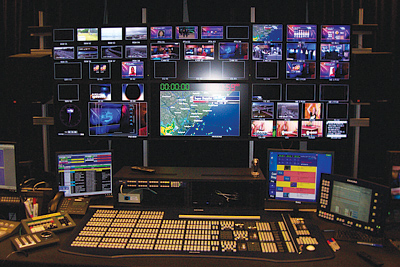Monitoring Multiview Displays
LOS ANGELES Providers of master control equipment now offer various ways to monitor video, audio and metadata for multiple feeds, thanks to recent technological breakthroughs. Some solutions focus on getting incoming signals to and around multiview displays, and monitoring certain technical parameters of those signals for exceptions. Others have expanded monitoring to include aspects of the content within the signals, examining things like stereo pairing of the audio, the accuracy of closed captions, and relative darkness/stillness.
Snell & Wilcox developed Hyperion to pursue the second approach through various algorithms. "Hyperion technology enables you have the algorithmic equivalent of a set of eyes and ears on all your video, all your audio and all your metadata," said Joe Zaller, vice president of corporate development for Snell & Wilcox. Hyperion can also "stamp the content coming into a facility with metadata, and then look at the metadata on the way out of the facility to know mathematically [whether] the contents are supposed to be on [there]."
Hyperion was initially built into the company's control monitoring network, RollCall. This year it debuted a standalone version, QC Station, which can be integrated into any multiview display.
OUTSIDE THE BOX
In the early development of multiview displays, manufacturers were hard pressed to scale up the delivery of incoming channels due to bandwidth constraints posed by the their products' internal buses. Looking outside the box, they found a considerable amount of potential bandwidth offered by routers. The advent of 3G (and better) technologies—and the cabling accommodating them—facilitated signal movement from router to display, making the router-display pairing inevitable.

WCSC-TV has launched South Carolina's first full HD newscast using the Miranda Kaleido-X multi-image display system for monitoring. Superimposing a control system over the two technologies further streamlined the process, while minimizing configuration and space requirements. The integrated system also offered greater flexibility due to its ability to designate throughput and expand via modular options. Evertz' VIP-X and Harris' Centrio are examples of these types of systems. Nvision partnered with Miranda Technologies and Dutch-based Axon Digital Design to offer two other options. Miranda also partnered with router manufacturers Pro-bel and Utah Scientific.
The Evertz offering pairs its Xenon or EQX routers with its MVP or VIP multi-display solutions, according to Orest Holyk, director of sales for the Burlington, Ontario-based company. Its X-Link, a high density cable which (with the MVP server and Maestro software), transforms the aforementioned components into the VIP-X Control Room Routing Platform and Modular Multi-Image Display System, was introduced at the 2008 NAB Show.
VIP-X incorporates nonproprietary SNMP; it monitors video, audio, data, signal strength, and other parameters.
Holyk said its next version transmits signals between the router and multidisplay processors via fiber, which generates optical versus electrical signals. "An optical signal can't be bugged," he said.
Nvision introduced its NV8576 series of routers this year, beginning with the largest of the series at this year's NAB Show. Commercial deliveries of the smaller NV8280 version are ex-pected in December, with the still smaller NV8144 due at the 2009 NAB Show.
The router is paired with one of two multidisplay monitors: Miranda Technologies' Kaleido-X multiviewer or the Synapse Multiview, made by Axon (though, for U.S. sales, the Nvision logo on its casement). According to Kevin Basquill, Nvision's business development manager of international sales, "Axon designs and manufactures the Synapse product line. Nvision has input into the design [and it] re-brands, markets and services the product line in the US."
Paul Greene, director of business development for Nvision said many of his clients are "using the 8576 as a versatile distribution amplifier." To date the technology monitors video; audio monitoring is expected by January.
INFIELD PLAY
Among the most recent customers of the NV8576/Kaleido-X integrated system was Major League Baseball, which installed it for its new MLB Network, slated to debut Jan. 1, (see "All Baseball, All the Time," Oct. 15). The network is broadcasting out of the former MSNBC studios in Secaucus, N.J., which was undergoing a massive retrofitting at press time.
"This is somewhat of a highlight factory," said Mark Hadden, vice president, engineering and IT, in describing the facility. "The workflows are very similar to a news operation: there are going to be a lot of events flying at us at once. The multiviewer is the perfect way to see a 30,000 foot view of everything coming out you at once—and each person can be looking at something different."
Hadden and systems integrator Scott Griffin, vice president of engineering & technology at The Systems Group, also noted that the system was primed to accommodate changes in workflow as well as operator preferences.
"Before the heavy game time, the room might be used for building archives from tape; once the games start, the rooms are dedicated to supporting production and bringing in the games themselves," said Griffin. "This product allows [presets] with a pretty expandable output side. And it also allows you to bring sources to many, many output sides."
Griffin saw the current router-multiviewer technology as a preliminary "heads up."
"In the ultimate configuration we're going to want to see audio channelization, we're going to want to see loss of signal [data]," he said. "But from day one we're able to go with the quality control station being routable."
The professional video industry's #1 source for news, trends and product and tech information. Sign up below.
